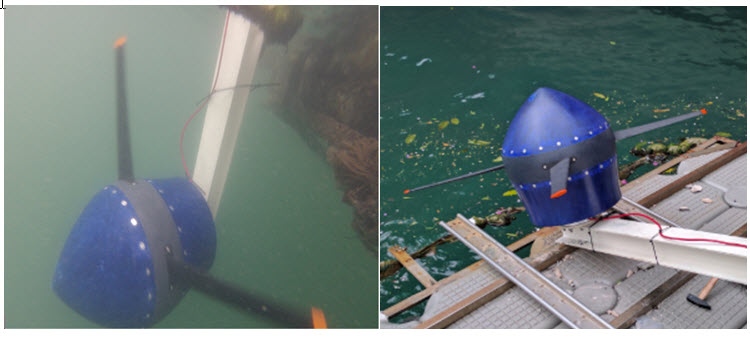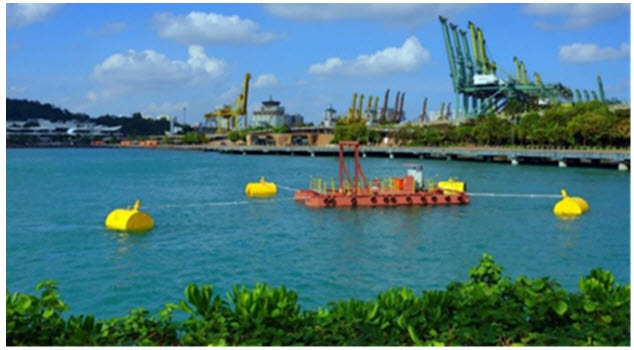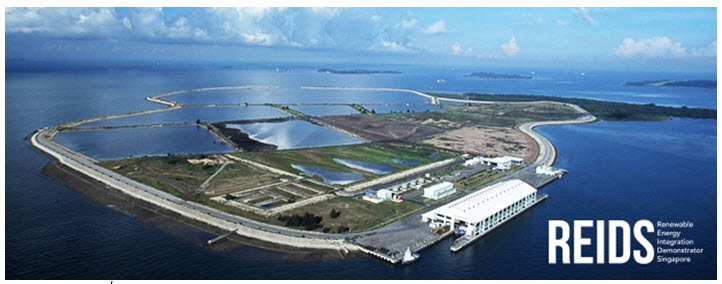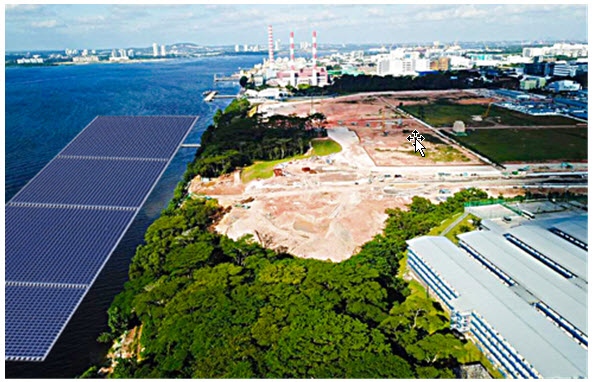SINGAPORE
TECHNOLOGY DEMONSTRATION
OPEN SEA TEST SITES
Sentosa – ERI@N Tidal Site
The Sentosa Tidal Test Site is a joint collaboration between Sentosa Development Corporation (SDC) and ERI@N, funded by the Ministry of Trade and Industry’s Core Innovation Fund. This project aims to showcase tidal energy extraction as a feasible and sustainable energy generating technology in Singapore and to provide opportunities to develop local technologies to harness the energy available in the narrow channel between Singapore and Sentosa. In November 2013, ERI@N and SDC officially launched the Sentosa Tidal Test Site (NTU, 2013). Recent developments on the test site include the deployments of tidal turbines supported from the floating barges. Also, novel concepts such as anti-biofouling coatings are being evaluated for better field performance. The power developed is used for electric lighting on the boardwalk.
 Floating hinged turbine support frame to house tidal turbines and vortex induced vibration devices (Left), Scaled (1:3) tidal turbine in tow tank (Middle) and successful deployment of the turbine at Sentosa Test site. (Right) Floating hinged turbine support frame to house tidal turbines and vortex induced vibration devices (Left), Scaled (1:3) tidal turbine in tow tank (Middle) and successful deployment of the turbine at Sentosa Test site. (Right) |
OPERATIONAL PROJECTS
 MAKO.4 Tidal turbine which was demonstrated in ERI@N tidal site, Sentosa MAKO.4 Tidal turbine which was demonstrated in ERI@N tidal site, Sentosa |
 Barge based floating Tidal system Barge based floating Tidal system |
PLANNED DEPLOYMENTS
The REIDS onshore project aims to solve engineering, economic, environmental and societal energy transition challenges for off grid communities. It customizes grid science towards remote islandic needs and integrates various renewables. Technologies deployed at the test bed include solar photovoltaic, wind, tidal, energy storage, bioenergy, innovative water desalination, hydrogen production, etc. Presently, work is in progress to make the island energy self-sufficient with its renewable sources.
 Renewable Energy Integration Demonstrator Singapore Renewable Energy Integration Demonstrator Singapore |
The offshore renewable energy integration and demonstration (Offshore REIDS) project, also termed as Tropical Marine Energy Centre (TMEC), has been initiated by ERI@N and financially funded by the ClassNK firm (a Japanese classification society) and seeks to pave the way for establishing the world’s first scaled marine renewable energy testing facility for tropical needs. In March 2015, the feasibility study for the test sites was officially launched and is expected to be completed by December 2017. During this project, the resource mapping methodologies are well utilized to identify the ocean energy potential of the southern islands of Singapore that have been identified from the Maritime Port Authority of Singapore (MPA). Presently, an environmental impact assessment (EIA) for the test sites is being carried out to understand the impact of ocean energy system deployment on marine life and environment. The EIA includes investigating the baseline conditions, possible effects of the test sites in the surroundings, and other associated research, such as underwater acoustics, water purity, sea level changes, tidal flow effects, etc. Geotechnical and geophysical surveys are also being planned. The outcome of this project will be extended towards Singapore’s guidelines and standards development by working with Spring Singapore to support local supply chain’s marine energy resource mapping guidelines of new regions, such as our neighbouring region of Southeast Asia and other tropical islands and remote coastal regions. Overall, the present project aims to develop technologies and a methodology for meeting energy needs towards the remote island region.
Deployment of Clean energy Powered Water Generation System on Southern Islands of Singapore
Energy Research Institute @ Nanyang Technological University (ERI@N) with support from Singapore Government is planning to deploy clean energy powered water generation system and renewable systems on southern islands of Singapore in order to support the water and energy needs of southern islands which attract large number of tourists every year.
 An illustration of Floating Solar along the Straits of Johor An illustration of Floating Solar along the Straits of Johor |
Floating Solar Deployment
Singapore’s Economic Development Board (EDB) has issued a request for information to explore the feasibility of a 100 MW floating solar project. The proposed facility will generate electricity for private sector consumption after construction. Such a facility will save 52,000 tonnes of carbon dioxide (CO2) emissions per year.
Sunseap Group, Southeast Asia’s leading sustainable energy provider, is developing one of the world’s largest offshore floating photovoltaic (OFPV) systems to be located north of Woodlands Waterfront Park, along the Straits of Johor. Supported by the Singapore Economic Development Board (EDB), the 5 MegaWatt-peak (MWp) floating solar system will generate about 6,388 MWh of renewable energy annually, once completed.



